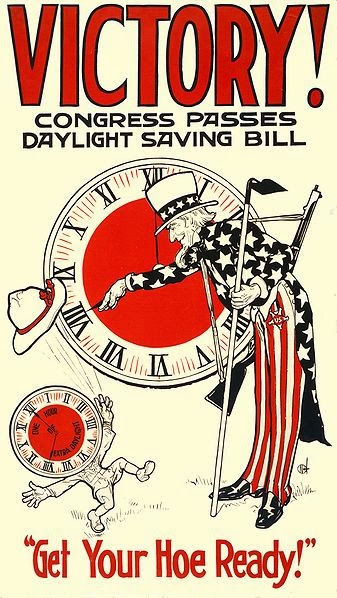SPRING AHEAD
Tomorrow we go back on daylight saving time, with the exception of Arizona (except for the Navajo Nation which does observe DST), Hawaii and other overseas territories. Not everyone welcomes Daylight Saving Time, but for people like me who suffer from SAD (Seasonal Affective Disorder) it is the most wonderful time of the year. And this winter has been a SAD winter of epic proportions, by now affecting even those who normally don't have SAD.
 |
| From: Wikimedia |
 |
| From: Wikimedia |
But, during World War I, the Germans decided to institute Sommerzeit (Daylight Saving) on April 30, 1916 as a means of saving coal for the war effort. It didn't take long for the Britain and other Allied countries in Europe to follow the Germans. Despite entering the war in 1917, the US, however, didn't change their clocks until 1918.
Changing clocks results in all kinds of problems in farming, manufacturing, railroad schedule, etc., so when World War I came to an end, Daylight Saving pretty much did as well - quickly.
 |
| From: Library of Congress World War I |
In the US, President Roosevelt signed a law the created "War Time" which would advance time by one hour for the duration of the war. War Time lasted from February 9, 1942 until September 30, 1945. The aim was to save energy in order to speed up war production and it was estimated that 736,282,000 kilowatt hours of electricity for the war. In fact, at the end of the war, it was estimated that 4,800,000,000 kilowatt hours were saved. I don't know much about kilowatts, but I guess this is a pretty impressive amount.
While War Time ended, Daylight Saving didn't. It continued in a haphazard manner until 1966, when President Johnson signed the Uniform Time Act. This made the beginning and end of DST uniform in the states that chose to observe it. DST began the last Sunday in April and ended the last Sunday in October.
In 2005, Congress passed the Energy Policy Act which changes the beginning and end of Daylight Saving Time again. Since then, there have been a few other changes, but now we spring forward the second Sunday in March, and my fellow SAD sufferers, more daylight is ours until the first Sunday in November.
 |
| From: Library of Congress World War I |


Thank you, Alex for the great history lesson. I love learning more about this. I don't have SAD but more daylight hours do make me happy. British Double Summer Time - what a terrific name.
ReplyDeleteHere's to less snow, more summer and much happiness for you.
Thanks, Joyce. I am already feeling better since watching the sun set later yesterday. I like the name British Double Summer Time, too. Wonder why it has never been mentioned in any of the books I've read.
ReplyDeleteOnce I get past my lost hour, I love DST. Hubby wishes it would stick around all year & spare us the chore of changing clocks.
ReplyDeleteI am definitely with your husband on that score - keep the clocks set forward year round. But it is a good reminder to change the batteries in smoke alarms.
DeleteI can't believe that people didn't start in full force until the 60s! I had no idea. I do love having it lighter in the evening. I feel like I can get so much more done when I leave work and I feel happier. Spring is in the air. :)
ReplyDeleteI know, it does feel like the day isn't over so early and I also get more done in Spring and Summer. Oh, I hope Sping and warmer temperatures are in the air.
DeleteThanks for the most excellent history lesson Alex. Personally I think DLT should be removed, it's silly, annoying and is mainly still in effect as a scam to generate more revenue for the utilities companies since DLT (here are a bunch of studies most of them find that households use more energy).
ReplyDelete